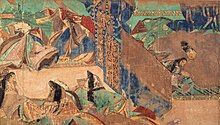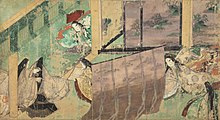The Tale of Genji
It is one of history's first novels, the first by a woman to have won global recognition, and in Japan today has a stature like that of Shakespeare in England.Murasaki's own diary includes a reference to the tale, and indeed the application to herself of the name 'Murasaki' in an allusion to the main female character.Genji visits Kitayama, a rural hilly area north of Kyoto, where he finds a beautiful ten-year-old girl.He is succeeded by his son Suzaku, whose mother (Kokiden), together with Kiritsubo's political enemies, take power in the court.He exiles Genji to the town of Suma in rural Harima Province (now part of Kobe in Hyōgo Prefecture).In the capital, the Emperor Suzaku is troubled by dreams of his late father, Kiritsubo, and something begins to affect his eyes.Meanwhile, his mother, Kokiden, grows ill, which weakens her influence over the throne, and leads to the Emperor ordering Genji to be pardoned.His political status does not change, but his love and emotional life begin to incrementally diminish as middle age takes hold.The chapters involve Kaoru and Niou's rivalry over several daughters of an imperial prince who lives in Uji, a place some distance away from the capital.Arthur Waley, who made the first English translation of the whole of The Tale of Genji, believed that the work as we have it was finished.Edward Seidensticker, who made the second translation of the Genji, believed that Murasaki Shikibu had not had a planned story structure with an ending as such but would simply have continued writing as long as she could.Because it was written to entertain the Japanese court of the 11th century, the work presents many difficulties to modern readers.[9] Modifying or rephrasing a classic poem according to the current situation was expected behavior in Heian court life, and often served to communicate thinly veiled allusions.As with most literature in the Heian period, Genji was written mostly in kana (Japanese phonetic script), specifically hiragana, and not in kanji.Some scholars have posited the earlier existence of a chapter between 1 and 2 which would have introduced some characters that seem to appear very abruptly in the book as it stands.Professor Katō Yōsuke said, "This is an important discovery as it asserts that non-Teika manuscripts were being read during the Kamakura period."On 29 October 2008, Konan Women's University announced that a mid-Kamakura period manuscript had been found,[18][19][20] containing the 32nd chapter, Umegae.[18] On 9 October 2019, it was announced that an original copy of Teika's Aobyōshibon had been found in Tokyo at the home of the current head of the Okochi-Matsudaira clan, who ran the Yoshida Domain.The Tale of Genji was written in an archaic court language, and a century after its completion it was difficult to read without specialized study.There are several annotated versions by novelists, including Seiko Tanabe, Jakucho Setouchi and Osamu Hashimoto.[25] Many works, including a manga series and different television dramas, are derived from The Tale of Genji.[29] In 1976, Edward Seidensticker published the first complete translation into English, made using a self-consciously "stricter" approach with regards to content if not form.[30] The English translation published in 2001 by Royall Tyler aims at fidelity in content and form to the original text.He said of it, "The Tale of Genji, as translated by Arthur Waley, is written with an almost miraculous naturalness, and what interests us is not the exoticism—the horrible word—but rather the human passions of the novel.The novelist Yasunari Kawabata said in his Nobel Prize acceptance speech: "The Tale of Genji in particular is the highest pinnacle of Japanese literature.Even in Japan, the Tale of Genji is not universally embraced; the lesser-known Ochikubo Monogatari has been proposed as the "world's first full-length novel", even though its author is unknown.The Bank of Japan issued the 2000 yen banknote in her honor, featuring a scene from the novel based on the 12th-century illustrated handscroll.[48] The names of the chapters became a central element in a incense-based game called Genjikō, part of the larger practice of Monkō popular among the nobility.













The Tale of Genji (disambiguation)Murasaki ShikibuSuematsu KenchōArthur WaleyEdward G. SeidenstickerHelen McCulloughRoyall TylerDennis WashburnEarly Middle JapaneseMonogatariDewey DecimalJapanese literaturelady-in-waitingHeian periodorihoncourtiersAkiko YosanoEdward SeidenstickerHikaru GenjiemperorKiritsubo ConsortMinamotonovelsFujiwara clanFujiwara no Michinagadramatis personæfeudalhonorificmany charactersTosa MitsuokiSarashina NikkiMurasaki's own diaryYosano AkikoDaini no SanmiGenji Monogatari EmakiLady FujitsuboAoi no UeMurasaki no UeCrown PrinceHarima ProvinceHyōgo PrefectureAkashiSettsu Provincebikunianti-heroIvan Morrispoetryhiraganayamato kotobahomophonesKiritsuboSuetsumuhanaUkifuneTextual tradition of The Tale of GenjiFujiwara TeikaKamakura periodKonan Women's UniversityOkochi-Matsudaira clanYoshida DomainTokugawa Art MuseumNagoyaTokugawa clanGotoh MuseumNational Treasures of JapanKodanshaukiyo-eEdo periodTranslations into modern JapaneseanachronismsJun'ichirō TanizakiFumiko EnchiSeiko TanabeJakucho SetouchiWaki YamatoThe Tale of GenjiGenji MonogatariShogakukan Manga AwardBrailleSetagaya, TokyoLibrary of CongressThe Tale of the HeikeThe New York TimesJanice NimuraJorge Luis Borgespsychological novelYasunari KawabataNobel PrizeSanskritKādambariDaphnis and ChloeSatyriconhistorical novelOchikubo MonogatariPhilip SidneyArcadiaClassics DayKōzaburō YoshimuraTetsuji TakechiAsaki Yume MishiTakarazuka RevueGisaburō SugiiO Desejado ou As montanhas da luaPaulo RochaMiyako MakiMiki MinoruSennen no Koi Story of GenjiGenji Monogatari SennenkiOsamu DezakiSean Michael WilsonGhost storiesHagiwara HiromichiJūnihitoeSudareThe Pillow BookThe Tale of Genji MuseumTales of IseYang GuifeiYou Xian KuBirmingham Museum of ArtRichard BowringNihon Koten Bungaku DaijitenThe EconomistWayback MachineThe New York Times Book ReviewMonumenta NipponicaYomiuri Shimbun